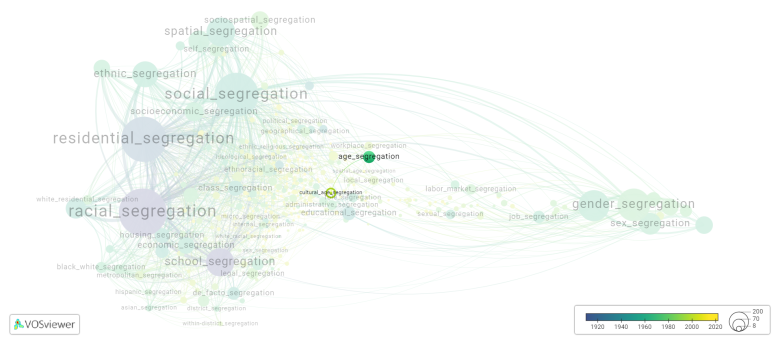Cultural age segregation: Difference between revisions
(Creating page) |
(Creating page) |
||
| Line 20: | Line 20: | ||
[[File:cultural_age_segregation.png|780x780px]] | [[File:cultural_age_segregation.png|780x780px]] | ||
This visualization is based on the study [[How_to_cite_Segregation_Wiki| The Multidisciplinary Landscape of Segregation Research]]. | |||
For the complete network of | For the complete network of interrelated segregation forms, please refer to: | ||
* | * [https://tinyurl.com/2235lkhw First year of publication] | ||
* | * [https://tinyurl.com/2d8wg5n3 Louvain clusters] | ||
* | * [https://tinyurl.com/223udk5r Betweenness centrality] | ||
* | * [https://tinyurl.com/244d8unz Disciplines in which segregation forms first emerged (Scopus database).] | ||
==References== | ==References== | ||
==Notes== | ==Notes== | ||
Revision as of 07:48, 10 October 2024
Date and country of first publication[1]
2006
Norway
Definition
Cultural age segregation refers to the separation of individuals based on their age groups within a specific culture or society. This segregation can occur in various areas of life, such as education, social interactions, employment, and leisure activities. It is a phenomenon that often arises due to differences in interests, experiences, and values between different age groups.
In many societies, cultural age segregation is most evident in educational institutions. Children typically attend school with peers of similar ages, while adults may pursue higher education or professional training separately from younger individuals. This separation enables the delivery of age-appropriate education and helps foster socialization among individuals with similar developmental needs and experiences.
Outside of educational settings, cultural age segregation can also be observed in social interactions and leisure activities. For example, teenagers may prefer to spend time with their peers engaging in activities that are specifically geared towards their age group, such as parties, concerts, or video gaming. On the other hand, older individuals may gravitate towards activities that are perceived as more mature, like book clubs, art galleries, or golfing.
Furthermore, cultural age segregation can be seen in the workplace as well. Organizations may have different departments or job roles specifically catering to different age groups. Younger employees may be more likely to hold entry-level positions or jobs that require technological skills, while older employees may occupy senior management positions that rely on experience and accumulated knowledge.
While cultural age segregation can provide opportunities for individuals to connect with peers who share similar interests and experiences, it can also lead to societal fragmentation and misunderstanding between different age groups. Encouraging intergenerational interactions and fostering understanding and respect among people of different ages can help bridge these gaps and create a more inclusive and cohesive society.
See also
Related segregation forms
Cultural age segregation is frequently discussed in the literature with the following segregation forms:
This visualization is based on the study The Multidisciplinary Landscape of Segregation Research.
For the complete network of interrelated segregation forms, please refer to:
References
Notes
- ↑ Date and country of first publication as informed by the Scopus database (December 2023).
At its current state, this definition has been generated by a Large Language Model (LLM) so far without review by an independent researcher or a member of the curating team of segregation experts that keep the Segregation Wiki online. While we strive for accuracy, we cannot guarantee its reliability, completeness and timeliness. Please use this content with caution and verify information as needed. Also, feel free to improve on the definition as you see fit, including the use of references and other informational resources. We value your input in enhancing the quality and accuracy of the definitions of segregation forms collectively offered in the Segregation Wiki ©.
Cultural age segregation appears in the following literature
Hagestad G.O., Uhlenberg P. (2006). Should we be concerned about age segregation? Some theoretical and empirical explorations. Research on Aging, 28(6), 638-653. https://doi.org/10.1177/0164027506291872

